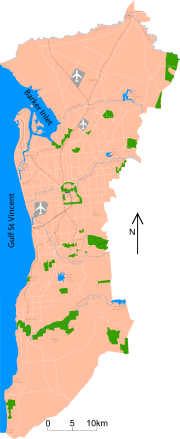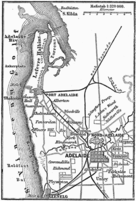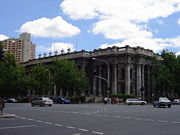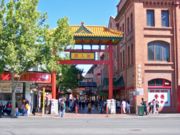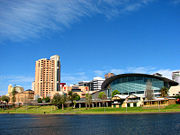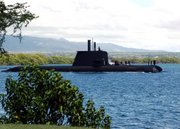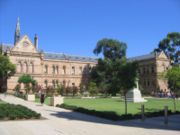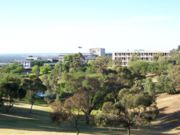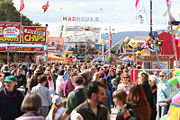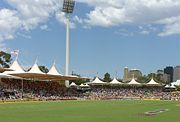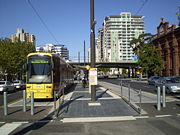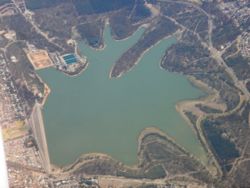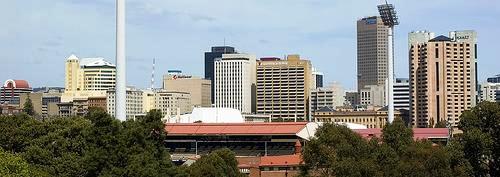Adelaide
2008/9 Schools Wikipedia Selection. Related subjects: Cities; Oceania (Australasia)
| Adelaide South Australia |
|||||||
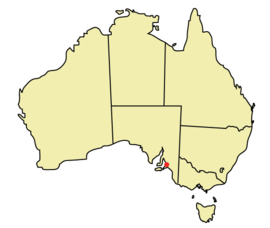 Location of Adelaide within Australia |
|||||||
| Population: | 1,146,119 (2006) ( 5th) | ||||||
| • Density: | 1295/km² (3354.0/sq mi) (2006) | ||||||
| Established: | 28 December 1836 | ||||||
| Area: | 1826.9 km² (705.4 sq mi) | ||||||
| Time zone: • Summer ( DST) |
ACST ( UTC+9:30) ACDT ( UTC+10:30) |
||||||
| Location: | |||||||
|
|||||||
Adelaide is the capital and most populous city of the Australian state of South Australia, and is the fifth largest city in Australia, with a population of over 1.1 million. It is a coastal city beside the Southern Ocean, and is situated on the Adelaide Plains, north of the Fleurieu Peninsula, between the Gulf St. Vincent and the low-lying Mount Lofty Ranges. It is roughly 20 km from the coast to the foothills but sprawls 90 km from Gawler at its northern extent to Sellicks Beach in the south.
Named in honour of Queen Adelaide, the consort of King William IV, the city was founded in 1836 as the planned capital for the only freely-settled British province in Australia. Colonel William Light, one of Adelaide's founding fathers, designed the city and chose its location close to the River Torrens in an area traditionally inhabited by the Kaurna aboriginal peoples. Light's design set out Adelaide in a grid layout, interspaced by wide boulevards and large public squares, and entirely surrounded by parkland. Early Adelaide was shaped by religious freedom and a commitment to political progressivism and civil liberties, which led to world-first reforms. Today Adelaide is known for its many festivals as well as for its wine, arts and sports.
As South Australia's seat of government and commercial centre, Adelaide is the site of many governmental and financial institutions. Most of these are concentrated in the city centre along the cultural boulevard of North Terrace, King William Street and in various districts of the metropolitan area.
History
Prior to British settlement, the Adelaide area was inhabited by the Kaurna Aboriginal tribe (pronounced "Garner" or "Gowna"). Acknowledged Kaurna country comprised the Adelaide Plains and surrounding regions - from Cape Jervis in the south, and to Port Wakefield in the north. Among their unique customs were burn-offs (controlled bushfires) in the Adelaide Hills which the early Europeans spotted before the Kaurna people were pushed out by settlement. By 1852, the total population (by census count) of the Kaurna was 650 in the Adelaide region and steadily decreasing. During the winter months, they moved into the Adelaide Hills for better shelter and firewood.
South Australia was officially settled as a new British province on 28 December 1836, near the The Old Gum Tree in what is now the suburb of Glenelg North. This day is now commemorated as Proclamation Day in South Australia. The site of the colony's capital city was surveyed and laid out by Colonel William Light, the first Surveyor-General of South Australia, through the design made by the architect George Strickland Kingston. In 1823, Light had fondly written of the Sicilian city of Catania: "The two principal streets cross each other at right angles in the square in the direction of north and south and east and west. They are wide and spacious and about a mile long", and this became the basis for the plan of Adelaide. Light chose, not without opposition, a site on rising ground close to the River Torrens, which became the chief early water supply for the fledgling colony. " Light's Vision", as it has been termed, has meant that the initial design of Adelaide required little modification as the city grew and prospered. Usually in an older city it would be necessary to accommodate larger roads and add parks, whereas Adelaide had them from the start. Adelaide was established as the centre of a planned colony of free immigrants, promising civil liberties and freedom from religious persecution, based upon the ideas of Edward Gibbon Wakefield. Wakefield had read accounts of Australian settlement while in prison in London for attempting to abduct an heiress, and realised that the eastern colonies suffered from a lack of available labour, due to the practice of giving land grants to all arrivals. Wakefield's idea was for the Government to survey and sell the land at a rate that would maintain land values high enough to be unaffordable for labourers and journeymen. Funds raised from the sale of land would be used to bring out working class emigrants, who would have to work hard for the monied settlers to ever afford their own land. As a result of this policy, Adelaide does not share the convict settlement history of other Australian cities like Sydney, Perth, Brisbane and Hobart.
Adelaide's early history was wrought by economic uncertainty and incompetent leadership. The first governor of South Australia, John Hindmarsh, clashed frequently with others, in particular with the Resident Commissioner, James Hurtle Fisher. The rural area surrounding Adelaide city was surveyed by Light in preparation to sell a total of over 405 km² of land. Adelaide's early economy started to get on its feet in 1838 with the arrival of livestock from New South Wales and Tasmania. The wool industry served as an early basis for the South Australian economy. Light's survey was completed in this period, and land was promptly offered to sale to early colonists. Wheat farms ranged from Encounter Bay in the south to Clare in the north by 1860. Governor Gawler took over from Hindmarsh in late 1838 and promptly oversaw construction of a governor's house, Adelaide Gaol, police barracks, hospital, and customs house and a wharf at Port Adelaide. In addition, houses for public officials and missionaries, and outstations for police and surveyors were also constructed during Gawler's governorship. Adelaide had also become economically self-sufficient during this period, but at heavy cost: the colony was heavily in debt and relied on bail-outs from London to stay afloat. Gawler was recalled and replaced by Governor Grey in 1841. Grey slashed public expenditure against heavy opposition, although its impact was negligible at this point: silver was discovered in Glen Osmond that year, agricultural industries were well underway, and other mines sprung up all over the state, aiding Adelaide's commercial development. The city exported meat, wool, wine, fruit and wheat by the time Grey left in 1845, contrasting with a low point in 1842 when one-third of Adelaide houses were abandoned.
Trade links with the rest of the Australian states were established with the Murray River being successfully navigated in 1853 by Francis Cadell, an Adelaide resident.
South Australia became a self-governing colony in 1856 with the ratification of a new constitution by the British parliament. Secret ballots were introduced, and a bicameral parliament was elected on 9 March 1857, by which time 109,917 people lived in the province.
In 1860 the Thorndon Park reservoir was opened, finally providing an alternative water source to the turbid River Torrens. In 1867 gas street lighting was implemented, the University of Adelaide was founded in 1874, the South Australian Art Gallery opened in 1881 and the Happy Valley Reservoir opened in 1896. In the 1890s Australia was affected by a severe economic depression, ending a hectic era of land booms and tumultuous expansionism. Financial institutions in Melbourne and banks in Sydney closed. The national fertility rate fell and immigration was reduced to a trickle. The value of South Australia's exports nearly halved. Drought and poor harvests from 1884 compounded the problems, with some families leaving for Western Australia. Adelaide was not as badly hit as the larger gold-rush cities of Sydney and Melbourne, and silver and lead discoveries at Broken Hill provided some relief. Only one year of deficit was recorded, but the price paid was retrenchments and lean public spending. Wine and copper were the only industries not to suffer a downturn.
Electric street lighting was introduced in 1900 and electric trams were transporting passengers in 1909. 28,000 men were sent to fight in World War I. Adelaide enjoyed a post-war boom but, with the return of droughts, entered the depression of the 1930s, later returning to prosperity under strong government leadership. Secondary industries helped reduce the state's dependence on primary industries. The 1933 census recorded the state population at 580,949, less of an increase than other states due to the state's economic limitations. World War II brought industrial stimulus and diversification to Adelaide under the Playford Government, which advocated Adelaide as a safe place for manufacturing due to its less vulnerable location. 70,000 men and women enlisted and shipbuilding was expanded at the nearby port of Whyalla.
The South Australian Government in this period built on former wartime manufacturing industries. International manufacturers like General Motors Holden and Chrysler (now Mitsubishi) made use of these factories around Adelaide completing its transformation from an agricultural service centre to a twentieth-century city. A pipeline from Mannum brought River Murray water to Adelaide in 1954 and an international airport opened at West Beach in 1955. An assisted migration scheme brought 215,000 immigrants of all nationalities to South Australia between 1947 and 1973. The Dunstan Government in the 1970s saw something of an Adelaide 'cultural revival' - establishing a wide array of social reforms and overseeing the city becoming a centre of the arts. Adelaide hosted the Australian Grand Prix between 1985 and 1996 on a street circuit in the city's east parklands, before losing it to Melbourne. The 1992 State Bank collapse plunged both Adelaide and South Australia into economic recession, and its effects lasted until 2004, when ratings agency Standard & Poor's reinstated South Australia's AAA credit rating. Recent years have seen the Clipsal 500 V8 Supercar race make use of sections of the former Formula One circuit.
Geography
Adelaide is located north of the Fleurieu Peninsula, on the Adelaide Plains between the Gulf St Vincent and the low-lying Mount Lofty Ranges. The city stretches 20 km from the coast to the foothills, and 90 km from Gawler at its northern extent to Sellicks Beach in the south. According to the Australian Bureau of Statistics, the Adelaide Metropolitan Region has a total land area of 870 km², and is at an average elevation of 50 metres above sea level. Mount Lofty is located east of the Adelaide metropolitan region in the Adelaide Hills at an elevation of 727 metres. It is the tallest point of the city and in the state south of Burra.
Much of Adelaide was bushland before British settlement, with some variation - swamps and marshlands were prevalent around the coast. However, much of the original vegetation has been cleared with what is left to be found in reserves such as the Cleland Conservation Park and Belair National Park. A number of creeks and rivers flow through the Adelaide region. The largest are the Torrens and Onkaparinga catchments. Adelaide relies on its many reservoirs for water supply, with Mount Bold Reservoir and Happy Valley Reservoir together supplying around 50% of Adelaide's requirements.
Urban layout
Adelaide is a planned city, designed by the first surveyor-general of South Australia, Colonel William Light. His plan, now known as Light's Vision, arranged Adelaide in a grid, with five squares in the inner City of Adelaide and a ring of parks known as the Adelaide Parklands surrounding it. Light's design was initially unpopular with the early settlers, as well as South Australia's first Governor, John Hindmarsh. Light persisted with his design against this initial opposition. The benefits of Light's design are numerous; Adelaide has had wide multi-lane roads from its beginning, an easily-navigable grid layout and a beautiful green ring around the city centre. There are two sets of 'ring roads' in Adelaide that have resulted from the original design. The inner ring route borders the parklands and the outer route completely bypasses the inner city through (in clockwise order) Grand Junction Road, Hampstead Road, Ascot Avenue, Portrush Road, Cross Road and South Road.
Urban expansion has to some extent outgrown Light's original plan. Numerous satellite cities were built in the later half of the 20th century, notably Salisbury and Elizabeth on the city's northern fringes, which have now been enveloped by its urban sprawl. New developments in the Adelaide Hills region facilitated the construction of the South Eastern Freeway to cope with growth. Similarly, the booming development in Adelaide's South made the construction of the Southern Expressway a necessity. New roads are not the only transport infrastructure developed to cope with the urban growth, however. The O-Bahn Busway is an example of a unique solution to Tea Tree Gully's transport woes in the 1980s. The development of the nearby suburb of Golden Grove in the late 1980s is possibly an example of well-thought-out urban planning. The newer urban areas as a whole, however, are not as integrated into the urban layout as much as older areas, and therefore place more stress on Adelaide's transportation system – although not on a level comparable with Melbourne or Sydney.
Climate
Adelaide has a temperate / Mediterranean climate, with mild, wet winters and hot, dry summers.
| Jan | Feb | Mar | Apr | May | Jun | Jul | Aug | Sep | Oct | Nov | Dec | Year | ||
|---|---|---|---|---|---|---|---|---|---|---|---|---|---|---|
| Mean daily maximum temperature ( °C) | 32.1 | 31.3 | 29.2 | 26.3 | 23.0 | 19.1 | 17.3 | 18.2 | 22.1 | 25.4 | 27.2 | 30.0 | ||
| Mean daily minimum temperature (°C) | 20.0 | 19.1 | 17.1 | 15.3 | 13.2 | 11.1 | 9.4 | 10.2 | 13.4 | 15.2 | 17.3 | 18.1 | ||
| Mean total rainfall ( mm) | 19.2 | 13.7 | 26.2 | 38.7 | 62.6 | 83.1 | 77.8 | 68.1 | 63.6 | 48.5 | 29.6 | 26.8 | 558.1 | |
| Mean number of rain days | 4.3 | 3.4 | 5.7 | 7.9 | 12.3 | 15.4 | 16.2 | 16.4 | 13.2 | 10.8 | 8.1 | 6.7 | 120.5 | |
| Source: Bureau of Meteorology | ||||||||||||||
Governance
The Adelaide metropolitan area is divided between eighteen local government areas, including, at its centre, the City of Adelaide, which administers the CBD, North Adelaide, and the surrounding Adelaide Parklands. It is the oldest municipal authority in Australia and was established in 1840, when Adelaide and Australia's first mayor, James Hurtle Fisher, was elected. From 1919 onwards, the City has had a Lord Mayor, the current being Lord Mayor Michael Harbison.
Adelaide, as the capital of South Australia, is the seat of the Government of South Australia. As Adelaide is South Australia's capital and most populous city, the State Government co-operates extensively with the City of Adelaide. In 2006, the Ministry for the City of Adelaide was created to facilitate the state government's collaboration with the Adelaide City Council and the Lord Mayor to improve Adelaide's image. The state parliament's Capital City Committee is also involved in the governance of the City of Adelaide, being primarily concerned with the planning of Adelaide's urban development and growth.
Demography
As of 2006 Census, Adelaide had a metropolitan population of more than 1,105,839, making it Australia's fifth largest city. In the 2002-2003 period the population grew by 0.6%, while the national average was 1.2%. Some 70.3% of the population of South Australia are residents of the Adelaide metropolitan area, making South Australia one of the most centralised states. Major areas of population growth in recent years were in outer suburbs such as Mawson Lakes and Golden Grove. Adelaide's inhabitants occupy 341,227 houses, 54,826 semi-detached, row terrace or town houses and 49,327 flats, units or apartments.
Persons of high-income are concentrated on the coastal suburbs (such as Brighton and Glenelg), eastern suburbs (such as Wattle Park, Kensington Gardens and College Park) and inner south-eastern suburbs (such as Waterfall Gully and Unley). Almost a fifth (17.9%) of the population had university qualifications. The number of Adelaideans with vocational qualifications (such as tradespersons) fell from 62.1% of the labour force in the 1991 census to 52.4% in the 2001 census.
Over half of the population identifies as Christian, with the largest denominations being Catholic (22.1%), Anglican (14.0%), Uniting Church (8.4%) and Eastern Orthodox (3.8%). Approximately 24% of the population expressed no religious affiliation, compared with the national average of 18.7%.
Overall, Adelaide is ageing more rapidly than other Australian capital cities. Just over a quarter (26.7%) of Adelaide's population is aged 55 years or older, in comparison to the national average of 24.3%. Adelaide has the lowest number of children (under-15 year olds), which composed 17.8% of the population, compared to the national average of 19.8.
Overseas-born Adelaideans composed 23.7% (262,367) of the total population. The north-western suburbs (such as Woodville and Athol Park) and suburbs close to the CBD have a higher ratio of overseas-born residents. The five largest groups of overseas-born were from England (7.3%), Italy (1.9%), Scotland (1.0%), Vietnam (0.9%), and Greece (0.9%). The most-spoken languages other than English were Italian (3.0%), Greek (2.2%), Vietnamese (1.2%), Mandarin (0.8%), and Cantonese (0.7%).
Economy
Adelaide's economy is primarily based around manufacturing, defence technology and research, commodity export and corresponding service industries. It has large manufacturing, defence and research zones. They contain car manufacturing plants for General Motors Holden, and plants that produce electronic systems that are sold worldwide for applications in medical, communications, defence, automotive, food and wine processing and industrial sectors. The revenue of Adelaide's electronics industry has grown at over 15% per year since 1990. The electronics industry in Adelaide employs over 13,000 people, which is more than the automotive industry. Almost half of all cars produced in Australia are made in Adelaide. The global media conglomerate News Corporation was founded in and until 2004 incorporated in Adelaide and is still considered its 'spiritual' home by Rupert Murdoch. Australia's largest oil company, Santos (South Australia Northern Territory Oil Search), prominent South Australian brewery, Coopers, major national retailer Harris Scarfe and Australia's second largest listed investment company Argo Investments Limited call Adelaide their home. The collapse of the State Bank in 1992 resulted in large levels of state debt (as much as A$4 billion). The collapse had meant that successive governments had enacted lean budgets, cutting spending, which had been a setback to the further development of the city and state. The debt has recently been reduced with the State Government once again receiving a AAA+ Credit Rating. The South Australian economy, very closely tied to Adelaide's, still enjoys a trade surplus and has higher per capita growth than Australia as a whole.
Adelaide is home to a large proportion of Australia's defence industries, which contribute over AU$1 billion to South Australia's Gross State Product. 70% of Australian defence companies are located in Adelaide. The principal government military research institution, the Defence Science and Technology Organisation, and other defence technology organisations such as Tenix are located in Salisbury near RAAF Base Edinburgh and others such as Saab Systems near Technology Park. The Australian Submarine Corporation, based in the industrial suburb of Osborne was charged with constructing Australia's Collins class submarines and recently won a AU$6 billion contract to construct the Royal Australian Navy's new air-warfare destroyers.
There are 466,829 employed people in Adelaide, with 62.3% full-time and 35.1% part-time. In recent years there has been a growing trend towards part-time (which includes casual) employment, increasing from only 11.6% of the workplace in 1991, to over a third today. 15% of workers are employed in manufacturing, 5% in construction, 15% in retail trade, 11% in business services, 7% in education and 12% in health and community services. The median weekly individual income for people aged 15 years and over is $447 per week, compared with $466 nationally. The median family income is $1,137 per week, compared with $1,171 nationally. Adelaide's housing and living costs are substantially lower than that of other Australian cities, with housing being notably cheaper. The median Adelaide house price is half that of Sydney and two-thirds that of Melbourne. The 3 month trend unemployment rate to March 2007 was 6.2%. The Northern suburbs' unemployment rate is disproportionately higher than the other regions of Adelaide at 8.3%, while the East and South are lower than the Adelaide average at 4.9% and 5.0% respectively.
Education
Education forms an increasingly important part of the city's economy, with the South Australian Government and educational institutions attempting to position Adelaide as "Australia's education hub" and marketing it as a 'Learning City'. The number of international students studying in Adelaide has increased rapidly in recent years to 23,300, of which 2,380 are secondary school students. In addition to the city's existing institutions, foreign institutions have been attracted to set up campuses in order to increase its attractiveness as an education hub.
The tertiary education system in Adelaide is extensive. There are several institutes of TAFE South Australia throughout the city which provide vocational education and training. Additionally, there are three public and two private universities, all ranked within the world's top 400 in Times Higher Education. The University of Adelaide, with 20,478 students, is Australia's third-oldest and a member of the leading Group of Eight. It has five campuses throughout the metropolitan area, including two in the city-centre on North Terrace. The University of South Australia, with 30,901 students, also has two North Terrace campuses, of a total four throughout the metropolitan area. Flinders University, with 16,237 students, is located in Bedford Park alongside the Flinders Medical Centre.
Carnegie Mellon became the first foreign university to open in Australia when it established two postgraduate campuses in the city-centre in 2006: the Heinz School Australia in Victoria Square and the Entertainment Technology Centre in Light Square. Cranfield University followed suit in 2007 and established a postgraduate campus in Victoria Square alongside the Heinz School. Another leading institution, the University College London, will establish its first international campus alongside Carnegie Mellon and Cranfield University in 2009, with postgraduate courses commencing in 2010.
The two hundred year-old Royal Institution of Great Britain is also establishing an Australian counterpart in Adelaide which will formally open in 2009.
At the level of primary and secondary education, there are two systems of school education. There is a public system operated by the South Australian Government and a private system of independent and Catholic schools. All schools provide education under the South Australian Certificate of Education (SACE) or, to a lesser extent, the International Baccalaureate (IB), with Adelaide having the highest number of IB schools in Australia. One notable secondary school is St Peter's College, which has educated more Nobel laureates than any other school in Australia, and is tied for third internationally behind New York City's Bronx High School of Science and Stuyvesant High School.
Culture
While established as a British province, Adelaide attracted immigrants from many non-English speaking countries early-on, including German and other European non-conformists escaping religious persecution. The first German Lutherans arrived in 1838 bringing with them the vine cuttings that they used to found the acclaimed wineries of the Barossa Valley. After the Second World War, Italians, Greeks, Dutch, Poles and many other European nationalities came to make a new start. An influx of Asian immigrants following the Vietnam War, and more recently many African refugees, have added to Adelaide's multicultural mix. These new arrivals have blended with dominant Anglo-Saxon culture to form a rich and diverse cuisine and vibrant restaurant culture.
Arts and entertainment
Adelaide's arts scene flourished in the 1970s under the leadership of premier Don Dunstan, removing some of the more puritanical restrictions on cultural activities then prevalent around Australia. It was at this time that the renowned Adelaide Festival of Arts and Fringe Festival were established, and over time they have spawned sister events including the Adelaide Cabaret Festival, Adelaide Film Festival, Adelaide Festival of Ideas, Adelaide Writers' Week and WOMADelaide held predominately in the autumnal month of March. Other festivals include FEAST, one of Australia's three main queer culture celebrations; Tasting Australia, a biennual food and wine affair; and the Royal Adelaide Show, an annual agricultural and state fair. Reflecting the city's multiculturalism, there are many ethnic fairs including the German Schützenfest and Greek Glendi. Adelaide is also home to the Adelaide Christmas Pageant, the world's largest Christmas parade.
As the state capital, Adelaide is also home to a great number of cultural institutions with many located of the boulevard of North Terrace. The Art Gallery of South Australia, with around 35,000 works, holds Australia's second largest state-based collection. Situated adjacent are the South Australian Museum and State Library of South Australia, while the Adelaide Botanic Garden, National Wine Centre and Tandanya National Aboriginal Cultural Institute are located nearby in the East End. The Adelaide Festival Centre, on the banks of the Torrens, is the focal point for most cultural activity in the city, with other venues including Adelaide Entertainment Centre and the city's many smaller theatres, pubs and cabaret bars.
The music of Adelaide has produced various musical groups and individuals who have achieved both national and worldwide fame. This includes notably the Adelaide Symphony Orchestra, the Adelaide Youth Orchestra, rock bands The Angels, Cold Chisel, The Superjesus, Wolf & Cub, roots/blues group The Audreys, and popular hip-hop outfit Hilltop Hoods. Famous rocker, Jimmy Barnes, spent most of his youth in the northern suburb of Elizabeth, while the first Australian Idol winner, Guy Sebastian, hails from Golden Grove. American artist Ben Folds also bases himself in Adelaide. In addition to its own WOMADelaide, Adelaide attracts several touring music festivals including the Big Day Out and Laneway.
Sport
The main sports played professionally in Adelaide are Australian rules football, soccer and cricket. Adelaide is the home of two Australian Football League teams: the Adelaide Crows and Port Adelaide Power. A local Australian rules football league, the SANFL, is made up of nine teams from around Adelaide.
Adelaide's professional soccer team, Adelaide United, play in the A-League. Founded in 2003, their home ground is Hindmarsh Stadium, which has a capacity of 16,500 and is one of the few purpose-built soccer stadia in Australia.
The Adelaide 36ers and the Adelaide Lightning play in national basketball competitions, with home games at the Distinctive Homes Dome. The Adelaide Thunderbirds play in the trans-Tasman netball competition, with home games at ETSA Park. Most large sporting events take place at either AAMI Stadium or the historic Adelaide Oval, home of the Southern Redbacks cricket team. Adelaide hosts an international cricket test every summer, along with a number of One Day International cricket matches. Memorial Drive Park hosts the Adelaide International, a major men's tennis tournament in the lead-up to the Australian Open.
Adelaide hosts the Tour Down Under bicycle race, the largest cycling event outside Europe and the only with UCI ProTour status.
The Australian Grand Prix for Formula 1 racing was hosted by Adelaide from 1985 to 1995 on a street circuit in the city's eastern parklands. The Grand Prix became a source of pride and losing the event to Melbourne in a surprise announcement left a void that has since been filled with the highly successful Clipsal 500 for V8 Supercar racing, held on a modified version of the same street circuit. The Classic Adelaide, a rally of classic sporting vehicles, is also held in the city and its surrounds.
Infrastructure
Health
Adelaide's first hospital is the Royal Adelaide Hospital (RAH), founded in 1840, it is one of the major hospitals in Adelaide and is a teaching hospital of the University of Adelaide. It has a capacity of 705 beds. Two other RAH campuses specialising in specific patient services located in the suburbs of Adelaide - the Hampstead Rehabilitation Centre in Northfield, and the Glenside Campus Mental Health Service. The other three largest hospitals in the Adelaide area are The Women's and Children's Hospital (305 beds), which is located on King William Road in North Adelaide; the Queen Elizabeth Hospital (340 beds), located in Woodville and the Flinders Medical Centre (500 beds), which is located in Bedford Park. These hospitals are also associated with medical schools - the Women and Children's and Queen Elizabeth with the University of Adelaide and the Flinders Medical Centre with Flinders University.
In June 2007 The State Government announced a series of overhauls to the health sector that would see a new hospital constructed to replace the Royal Adelaide Hospital on the old railyards west of the Adelaide Railway Station. The new 800 bed hospital will cost AU$1.7bn, and be controversially renamed the Marjorie Jackson-Nelson Hospital, after the former Governor of South Australia.
In addition to these changes, major upgrades would see the Flinders Medical Centre become the primary centre for health care in the southern suburbs while upgrades for the Lyell McEwin Health Service in Elizabeth would see that become the centre for the north. While the trio of the Queen Elizabeth Hospital, Modbury Hospital and Noarlunga Hospital would become specialist elective surgery centres. The Repatriation General Hospital would also expand its range of specialty areas beyond veterans' health to incorporate stroke, orthopaedic rehabilitation and aged care.
Transport
Being centrally located on the Australian mainland, Adelaide forms a strategic transport hub for east-west and north-south routes. The city itself has a limited public transport system, which is managed by and known as the Adelaide Metro. The Adelaide Metro consists of a contracted bus system including the O-Bahn Busway, metropolitan railways, and the Adelaide- Glenelg Tram, which has also now been extended as a metropolitan tram through the city centre. Road transport in Adelaide has historically been comparatively easier than many of the other Australian cities, with a well-defined city layout and wide multiple-lane roads from the beginning of its development. Historically, Adelaide was known as a "twenty-minute city", with commuters having being able to travel from metropolitan outskirts to the city proper in roughly twenty minutes. However, these roads are now often considered inadequate to cope with Adelaide's growing road traffic.
Adelaide has one freeway, the South Eastern Freeway, connecting the city with the Adelaide Hills and beyond to Murray Bridge and two expressways; the Port River Expressway connecting Port Adelaide and Outer Harbour to interstate routes and the Southern Expressway, an interchangeable one-way road connecting the southern suburbs with the city proper. The Gawler Bypass skirting Gawler is another expressway style, high speed inter-urban corridor. A third expressway, the Northern Expressway (formerly the Sturt Highway extension), a northern suburbs bypass route, connecting the Gawler Bypass to Port Wakefield Road, is due to start construction in 2008. There are also plans for major upgrades to busy sections of South Road, Adelaide, including road widening and underpasses of Anzac Highway, Grange Road, Port Road and the Outer Harbour Railway Line, during the first stage.
Adelaide International Airport, located in Adelaide's west, is Australia's newest and most advanced airport terminal and is designed to serve in excess of 6.3 million passengers annually. The new dual international/domestic terminal replaces the old and ageing terminals known locally as the 'tin sheds', and incorporates new state-of-the-art features, such as glass aerobridges and the ability to cater for the new Airbus A380. In March 2007, Adelaide Airport was rated the world's second best airport in the 5-15 million passengers category at the Airports Council International (ACI) 2006 awards in Dubai.. The airport is designed to handle 27 aircraft simultaneously and is capable of processing 3,000 passengers per hour. Unusually for a major city, it is located only about seven kilometres from the CBD. Parafield Airport is Adelaide's second airport, mostly used for general aviation. It is located eighteen kilometres north of the CBD.
Utilities
Adelaide's energy requirements are met by a variety of companies who separately provide for the generation, transmission, distribution and retail sales of gas and electricity. Some of the major companies are: TRUenergy, which generates electricity; ElectraNet, which transmits electricity from the generators to the distribution network; ETSA Utilities (formerly a government-owned company which was privatised by the Olsen Government in the 1990s), which distributes electricity from transmission companies to end users; and AGL Energy, which retails gas and electricity. Substantial investment has been made in maintenance and reinforcement of the electricity supply network to provide continued reliability of supply.
Adelaide derives most of its electricity from a gas-fired plant operated by AGL Energy at Torrens Island, with more coming from power stations at Port Augusta and Pelican Point, and from connections to the national grid. Gas is mainly supplied from the Moomba Gas Processing Plant in the Cooper Basin, and is piped to Adelaide and other areas within the state. A small part of supply also comes from wind turbines at Sellicks Hill, and a trial of more turbines on city buildings is underway.
Adelaide's water supply is gained from its reservoirs: Mount Bold, Happy Valley, Myponga, Millbrook, Hope Valley, Little Para and South Para Reservoir. Further water demands result in the pumping of water from the River Murray. The provision of water services is by the government-owned SA Water.


